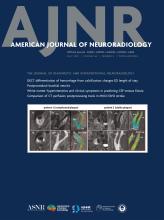This article requires a subscription to view the full text. If you have a subscription you may use the login form below to view the article. Access to this article can also be purchased.
Abstract
BACKGROUND AND PURPOSE: CSF-venous fistulas (CVFs) are a common cause of spontaneous intracranial hypotension. The diagnosis and precise localization of these fistulas hinges on specialized myelographic techniques, which mainly include decubitus digital subtraction myelography and decubitus CT myelography (by using either energy-integrating or photon-counting detector CT). A previous case series showed that conebeam CT myelography (CB-CTM), performed as an adjunctive tool with digital subtraction myelography, increased the detection of CVFs. Here, we sought to determine the additive yield of CB-CTM for CVF detection in a consecutive series of patients with spontaneous intracranial hypotension who underwent concurrent decubitus digital subtraction myelography and CB-CTM.
MATERIALS AND METHODS: We retrospectively searched our institutional database for all consecutive patients who underwent decubitus digital subtraction myelography with adjunctive CB-CTM between August 5, 2021 and August 5, 2024. We excluded any patients harboring extradural CSF on spine imaging, not meeting International Classification of Headache Disorders, 3rd edition criteria for spontaneous intracranial hypotension, or not having undergone technically successful CB-CTM in combination with digital subtraction myelography. All myelographic images were independently reviewed by 2 neuroradiologists. We calculated the diagnostic yield of both myelographic tests for localizing a CVF.
RESULTS: We identified 100 patients who underwent decubitus digital subtraction myelography with adjunctive conebeam CT. We excluded 15 patients based on above criteria. Fifty-nine of 85 patients had a single definitive CVF. Among positive cases, the fistula was visible on digital subtraction myelography in 38 of 59 patients and visible on CB-CTM in 59 of 59 patients. In 26 of 85 patients, no definitive fistula was identified by either technique.
CONCLUSIONS: CB-CTM increased the diagnostic yield for CVF detection and may be a useful addition to digital subtraction myelography.
ABBREVIATIONS:
- AP
- anterior-posterior
- CB-CTM
- conebeam CT myelography
- CVF
- CSF-venous fistula
- DSM
- digital subtraction myelography
- ICHD-3
- International Classification of Headache Disorders, 3rd edition
- PCD-CTM
- photon-counting detector CT myelography
- SIH
- spontaneous intracranial hypotension
- © 2025 by American Journal of Neuroradiology












